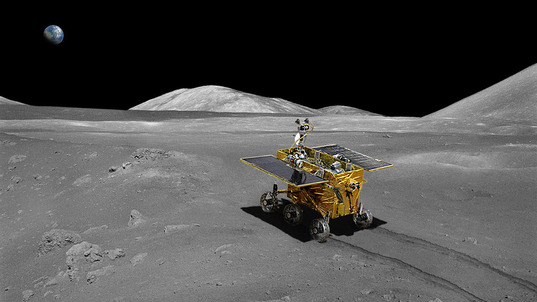David Schrunk, of "THE MOON - Resources, Future Development, and Settlement" book, let me know that the ILOA (International Lunar Observatory Association), headed by Steve Durst (Palo Alto and Big Island, Hawaii), has an agreement with the Chinese Academy of Sciences to use the Chang'e-3's UV telescope to conduct astronomical observations from the lunar surface.
I see that the ILOA also has an agreement with the Moon Express to use their telescope data when they go to the Moon.
See more information below.
- LRK -

Meet Brad and Jason and get a sneak peak inside the new Moon Express headquarters building at the NASA Ames Research Park in Silicon Valley, California.
------
Moon Express is a rapidly growing commercial space company developing a robotic lunar lander system to provide low cost frequent access to the lunar surface for science and commerce. The company currently has ~25 people and will reach 40-50 in the coming year as its lunar flight programs accelerate toward services beginning in 2014/15.
While delivering a suite of scientific and commercial payloads on its inaugural mission, Moon Express will also attempt to win the $30M Google Lunar X PRIZE competition.
Investigating Teaching and Learning in Virtual Worlds
Findings and Project Wrapup
The best way to learn is to do, but that is difficult if you want to understand the geologic evolution of the Moon which started evolving 4.5 billion years ago. The NASA-sponsored Classroom of the Future at Wheeling Jesuit University created a virtual lunar landscape in the virtual worlds Second Life and in OpenSim to provide everyone a chance to don a spacesuit and lope across the surface of the Moon. MoonWorld was a research project, funded by NASA, that is no longer active. This website describes MoonWorld and the lessons learned from its development and testing.
316 Washington Ave., Wheeling, WV 26003-6243. All rights reserved. Privacy Policy and Terms of Use.
A NASA Education EdLine Video featured CyGaMEs’ Selene I and MoonWorld
==============================
------------------------------
Larry,
You might be interested to know that the ILOA (International Lunar Observatory Association), headed by Steve Durst (Palo Alto and Big Island, Hawaii), has an agreement with the Chinese Academy of Sciences to use the Chang'e-3's UV telescope to conduct astronomical observations from the lunar surface.
(FYI - see www.iloa.org: In September 2012, ILOA signed a MoU with the National Astronomical Observatories of the Chinese Academy of Sciences (NAOC-CAS) allowing ILOA scientists to conduct Galaxy Observations with the UV telescope set to fly on the Chang’e-3 lunar lander in 2013.)
Thanks,
David
------------------------------
Some links from ILOA. See website for more information.
- LRK -
------------------------------
snip
- ILOA Joins Golden Spike Company In Pioneering Human Moon Mission, 6 December 2012
- ILOA Hawaii to Use 2013 China Chang'e-3 Moon Lander Telescope For Galaxy Imaging, PR Newswire, 7 September 2012
- Moon Express to Fly Lunar Telescope, Space Exploration Network, 30 July 2012
- ILOA Demonstrates Lunar-Based Observation / Communication Device From Summit Of Mauna Kea, PR Newswire, 20 December 2011
snip
------------------------------
The Moon Express Inc. is Headquartered in the
NASA Ames Research Park in Mountain View, CA,
- LRK -
------------------------------

Moon Express Inc. is a privately funded lunar transportation and data services company created to establish new avenues for commercial space activities beyond Earth orbit. Commonly referred to as Moon Ex, the company was founded by Dr. Bob Richards, Naveen Jain, and Dr. Barney Pell in August 2010 and officially entered the Google Lunar X Prize Competition (GLXP) in October of that same year. Headquartered in the NASA Ames Research Park in Mountain View, CA, Moon Express combines Silicon Valley lean start-up principles with expertise in aerospace engineering and planetary sciences. Selected by Forbes as one of the 'Names You Should Know' in 2011, Moon Express plans to send a series of robotic spacecraft to the Moon for ongoing exploration and commercial development focused on benefits to Earth and has signed a partnership agreement with NASA for the development of its lunar lander system..
snip
------------------------------
I enjoyed the skateboard tour of Ames having worked there for 20 years.
A bit sad to see my old Golden Bay Credit Union building empty,
but if Moon Express uses it, won't complain.
- LRK -
------------------------------
Rocket pioneer Tim Pickens joins Moon Express as Chief Propulsion Engineer and Establishes Huntsville Office
Legendary rocket designer Tim Pickens joins Moon Express in pursuit of the $30 Million Google Lunar X PRIZE more
Feb 14, 2013
snip
------
Published on Sep 29, 2012
Moon Express is a rapidly growing commercial space company developing a robotic lunar lander system to provide low cost frequent access to the lunar surface for science and commerce. The company currently has ~25 people and will reach 40-50 in the coming year as its lunar flight programs accelerate toward services beginning in 2014/15.
While delivering a suite of scientific and commercial payloads on its inaugural mission, Moon Express will also attempt to win the $30M Google Lunar X PRIZE competition.
------
snip
------------------------------
Moon Ex has plans for a number of missions. http://www.moonexpress.com/
Wish them success.
- LRK -
The best made plans do not always work out but maybe the time is right.
- LRK -
------------------------------
snip
LunaCorp, founded in 1989 by David Gump, promoted a private robotic rover mission to the Moon, to be funded by the entertainment value of having customers driving the rover around the Moon, plus commercial broadcast rights by the mass media of this copyrighted video, plus selling research data from any probes on the rover, plus supported by various sponsors who wanted their brand associated with the project.
The project actually made a lot of progress, but the company was surprisingly dissolved in 2003, not long after some high profile publicity.
Dr. Buzz Aldrin, the Apollo 11 astronaut and second man on the Moon, was a prominent advisor, and there were some highly reputable people doing actual work on the project.
The heart of the robotics work, however, became a rover named Nomad, designed and built by the Robotics Institute of Carnegie Mellon University, led by Dr. Red Whittaker.
Nomad was tested under extreme conditions in the Canadian Arctic in 2001, after $1 million of support was offered by NASA. Later, Nomad was also tested in the Atacama Desert in Chile, as well as in Antarctica.
The two main issues of the rover were dealing with the extreme temperatures of the Moon, and energy storage for nights.
snip
------------------------------
So an interest in going to the Moon and Moon Ex tours Buzz Aldrin
Nice YouTube with Buzz to the tune "Rocket Experience"
Watch the full version of Buzz Aldrin's song "Rocket Experience" here.
And now to get back to reading about graphics software as I thought it might help present a future lunar base, but even here there are folks that have been listening, so a look at what is at CET.
- LRK -
------------------------------
MoonWorldInvestigating Teaching and Learning in Virtual Worlds
Findings and Project Wrapup
snip
© 1999 - 2012 by Wheeling Jesuit University / Center for Educational Technologies ®.316 Washington Ave., Wheeling, WV 26003-6243. All rights reserved. Privacy Policy and Terms of Use.
MoonWorld was developed by The Classroom of the Future at Wheeling Jesuit University with funding from NASA
(Dr. Robert Starr, contract monitor).
(Dr. Robert Starr, contract monitor).
------------------------------
Thanks for looking up with me.
- LRK -
Web Site: http://lkellogg.vttoth.
BlogSpot: http://
WordPress: http://lrkellogg.
RSS link: http://
Newsletter: https://mailman1.
==============================
BlogSpot: http://
WordPress: http://lrkellogg.
RSS link: http://
Newsletter: https://mailman1.
==============================
Next SpaceX Dragon Flight Prepares to Resupply Space Station
In what soon may come to be considered routine, SpaceX will launch its Dragon spacecraft on another resupply mission to the International Space Station. NASA and its international partners are targeting Friday, March 1, as the launch date.
In what soon may come to be considered routine, SpaceX will launch its Dragon spacecraft on another resupply mission to the International Space Station. NASA and its international partners are targeting Friday, March 1, as the launch date.
snip
==============================
CyGaMEs’ Selene II: A Lunar Construction Game
Would Young People Learn Science Better if it Were Packaged in a Videogame?
WHEELING, W.V. — That’s the question at the heart of the Selene project. Originally funded by NASA and now carried on through a four-year grant from the National Science Foundation, Selene studies videogame learning and the ways researchers can assess how effectively that learning takes place.
The Center for Educational Technologies® at Wheeling Jesuit University created the Selene online game to see how organizations like NASA could best use videogames to introduce important science concepts.
WHEELING, W.V. — That’s the question at the heart of the Selene project. Originally funded by NASA and now carried on through a four-year grant from the National Science Foundation, Selene studies videogame learning and the ways researchers can assess how effectively that learning takes place.
The Center for Educational Technologies® at Wheeling Jesuit University created the Selene online game to see how organizations like NASA could best use videogames to introduce important science concepts.
snip
A NASA Education EdLine Video featured CyGaMEs’ Selene I and MoonWorld
2012 International Science & Engineering Visualization Challenge
The Selene videogame created by the CyGaMEs project at the Center for Educational Technologies at Wheeling Jesuit University has earned top honors in the games and apps category of the International Science & Engineering Visualization Challenge.
The Selene videogame created by the CyGaMEs project at the Center for Educational Technologies at Wheeling Jesuit University has earned top honors in the games and apps category of the International Science & Engineering Visualization Challenge.
snip
==============================
WHAT THE MIND CAN CONCEIVE, AND BELIEVE, IT WILL ACHIEVE - LRK -
==============================








